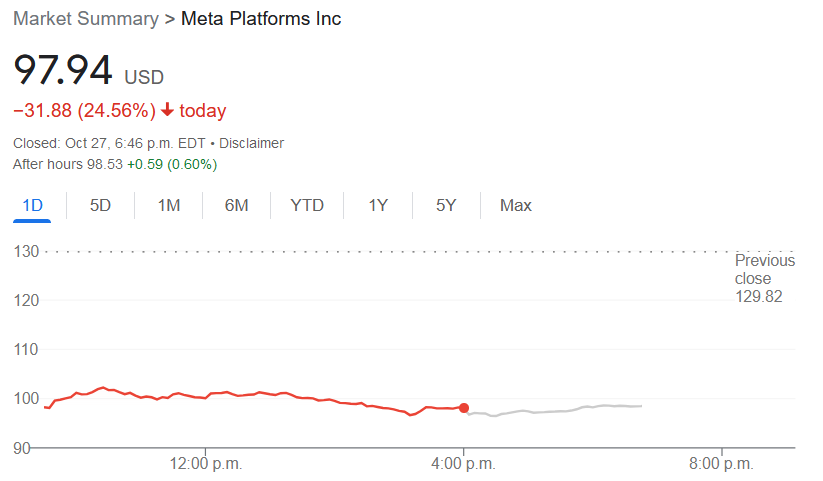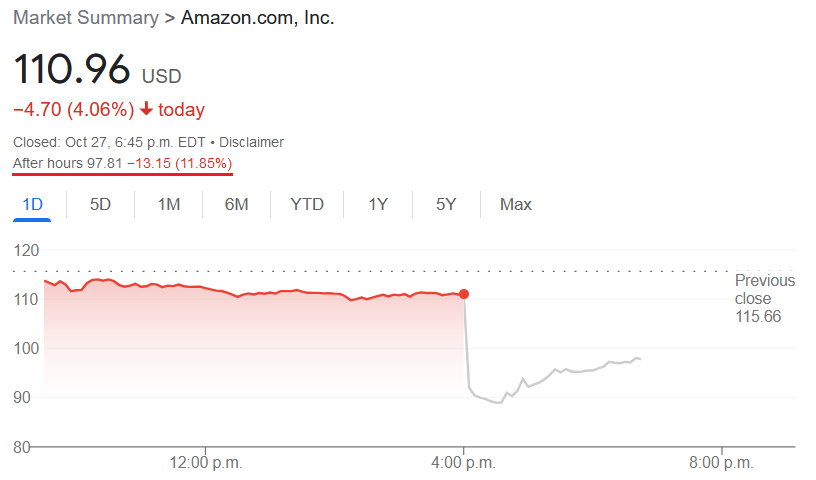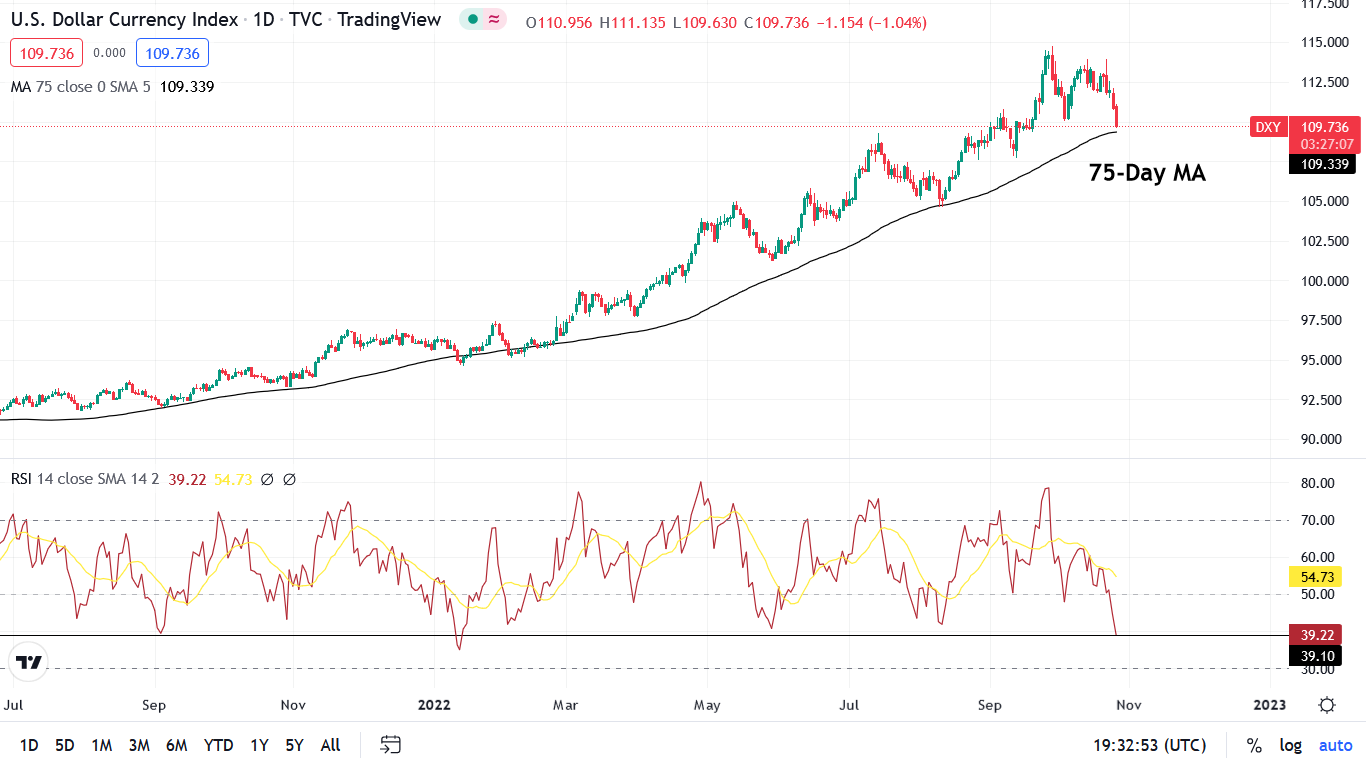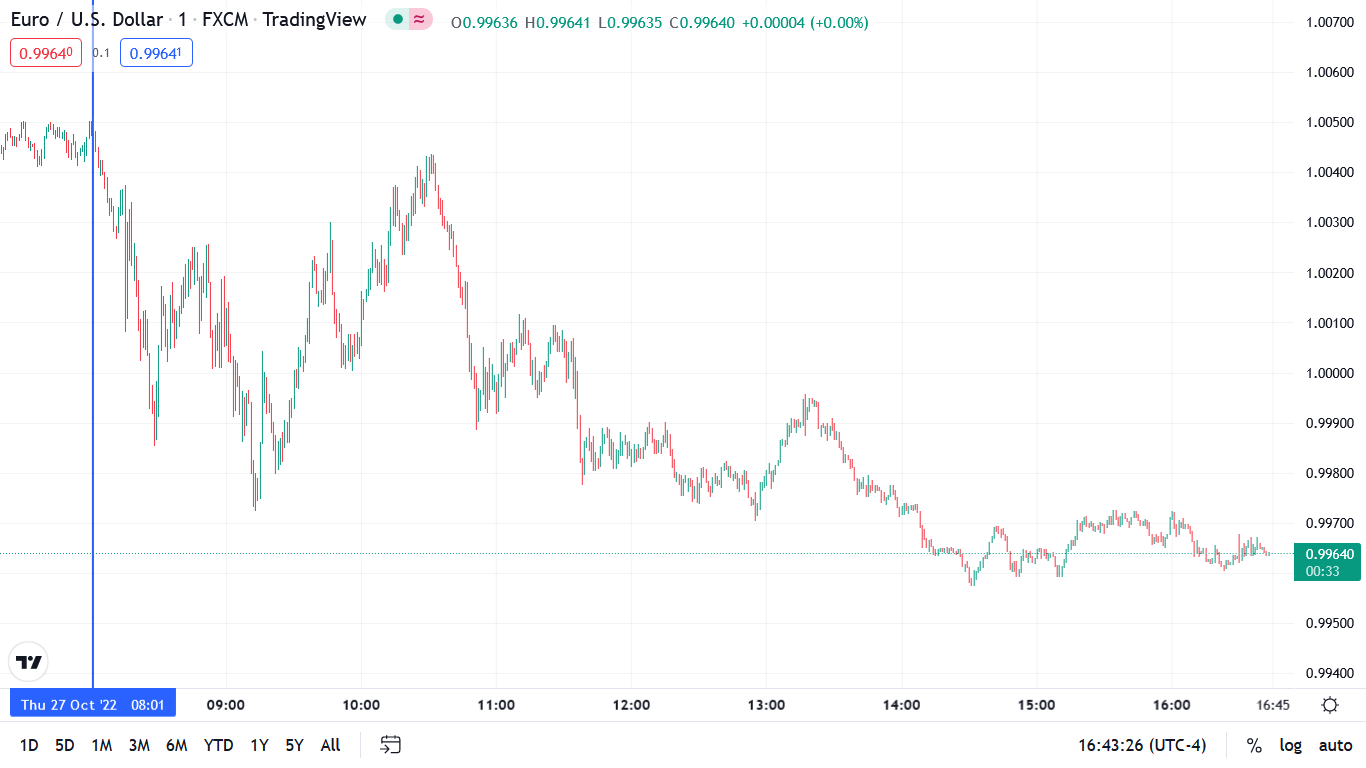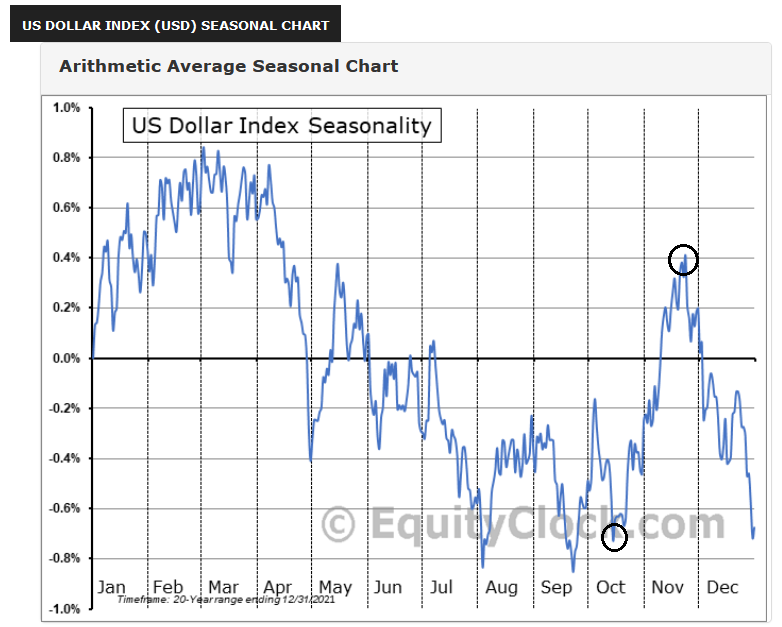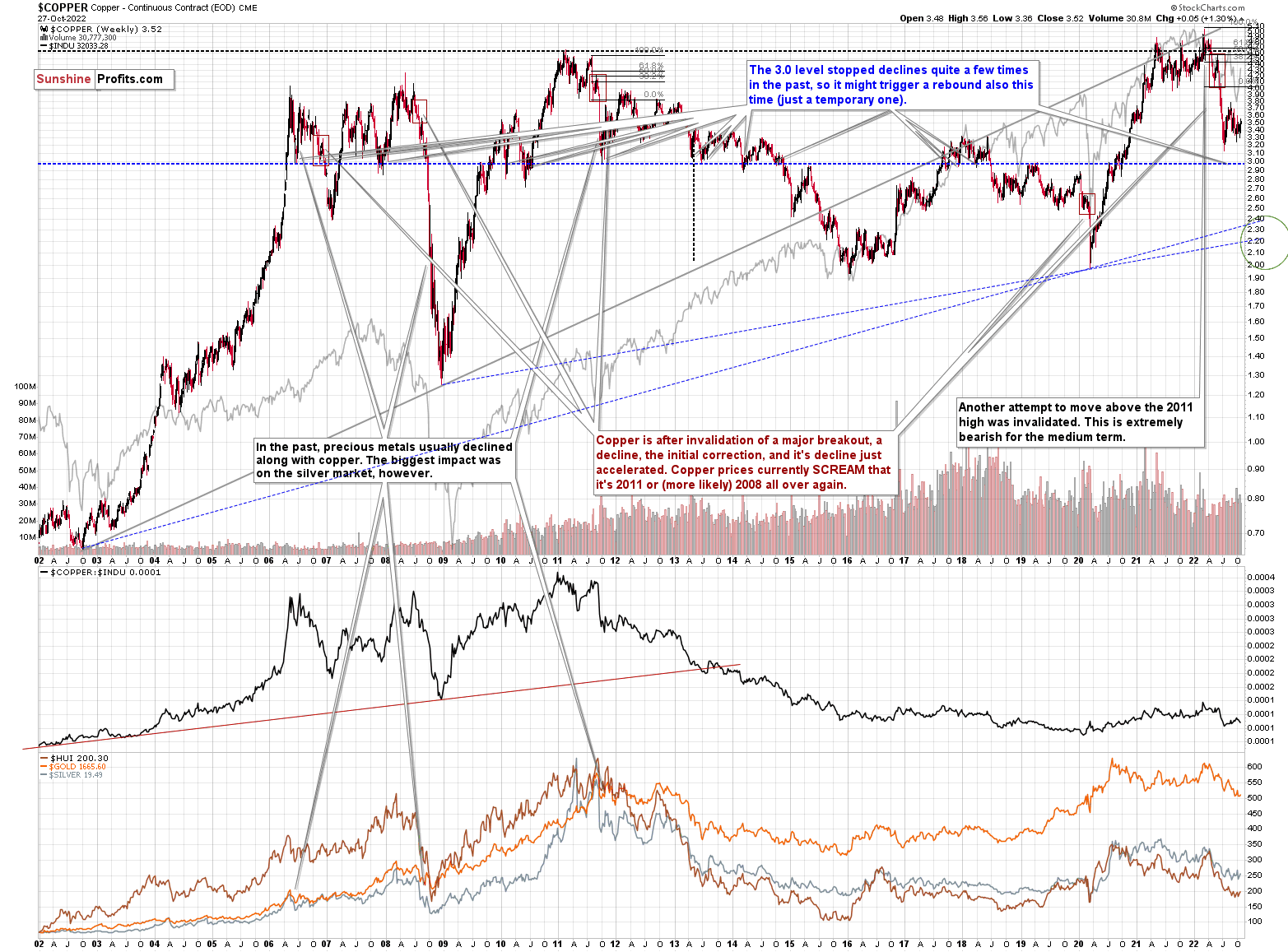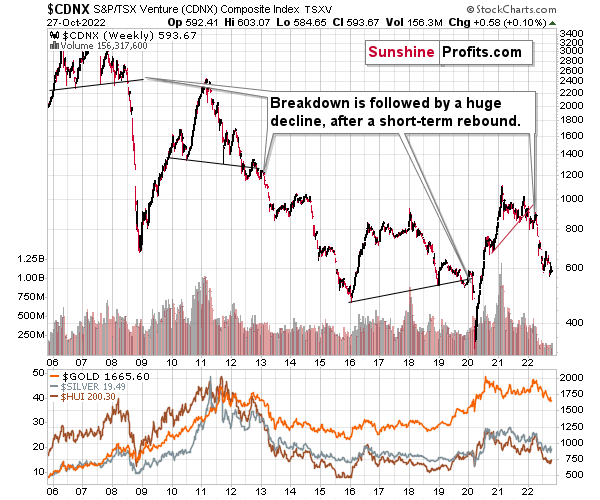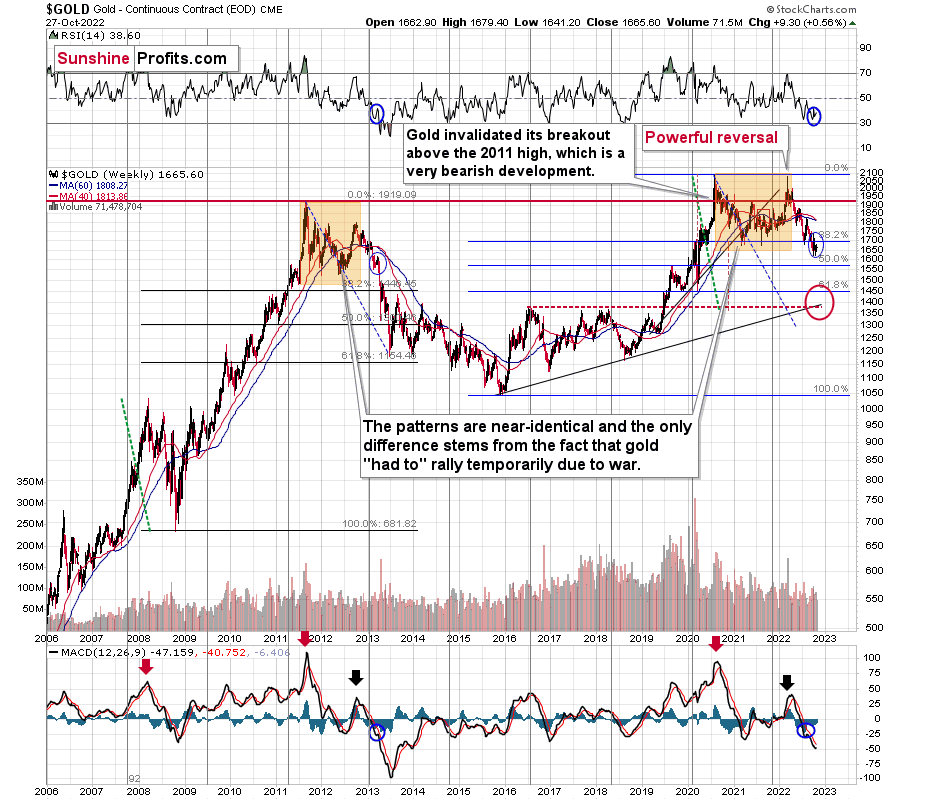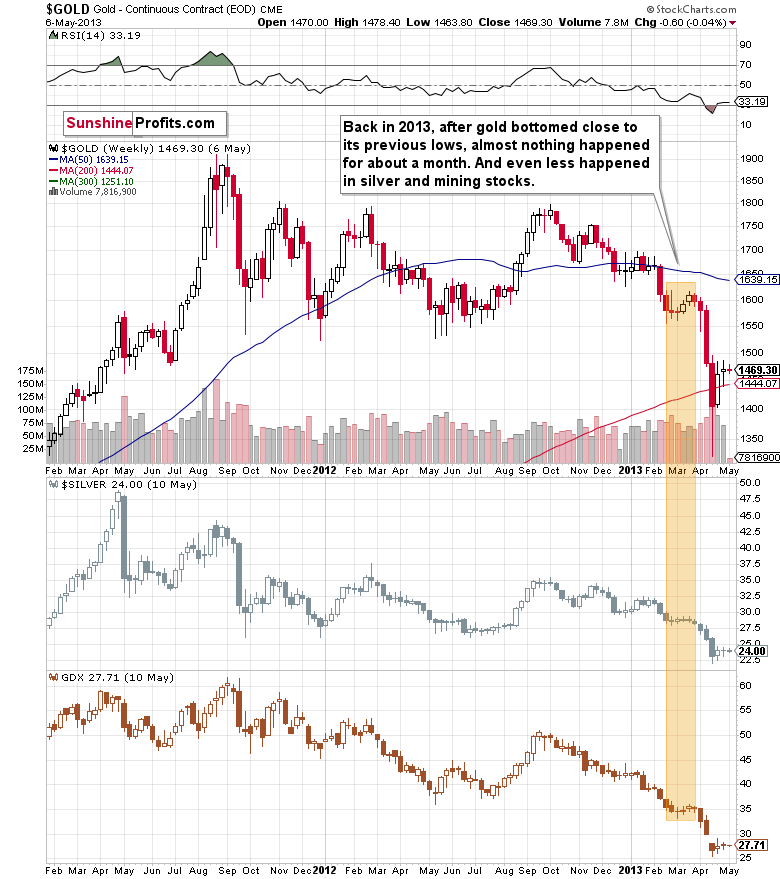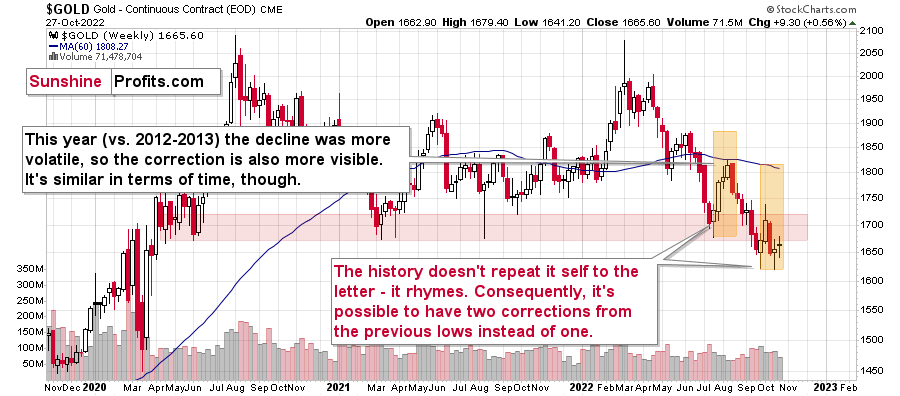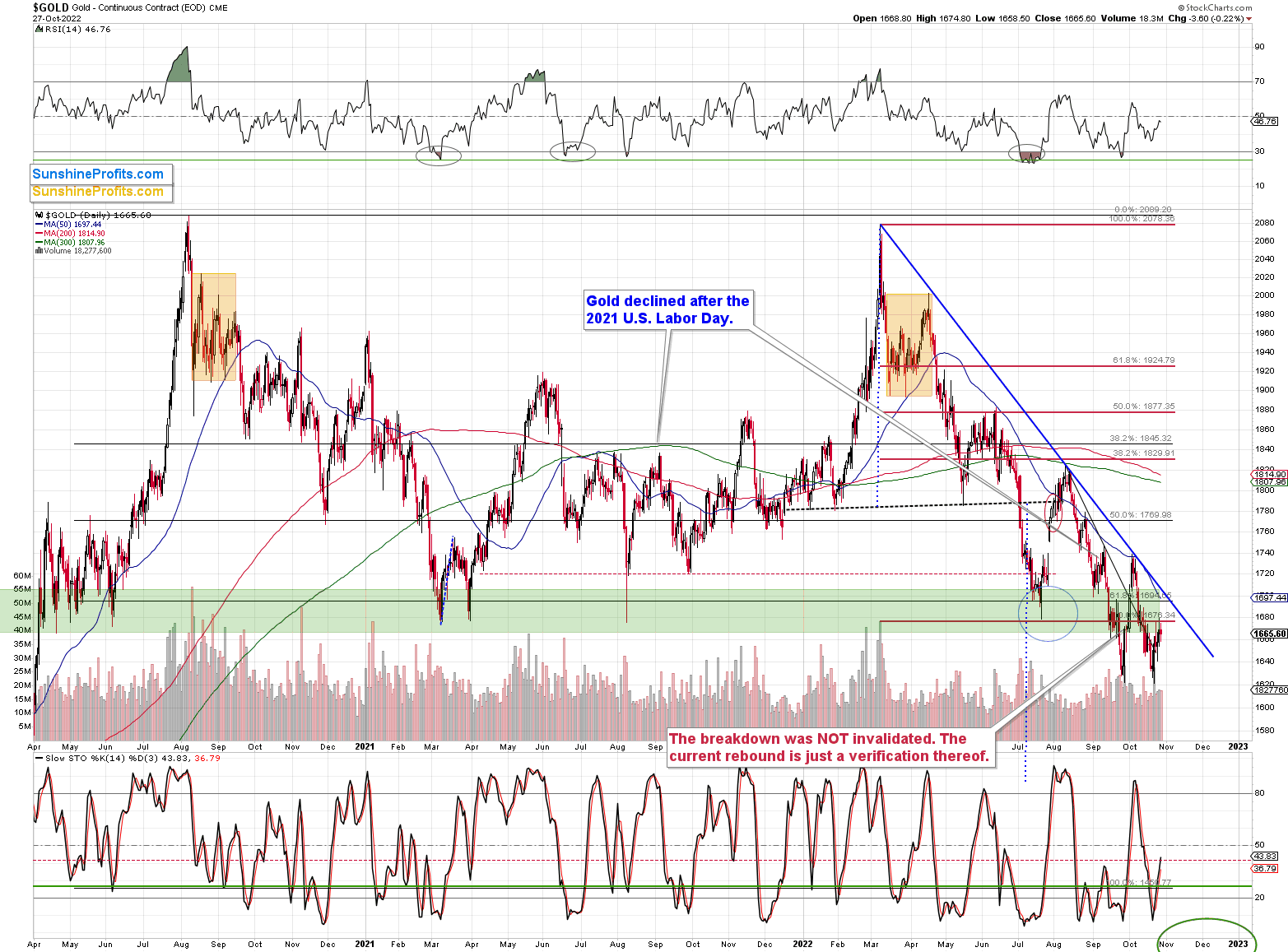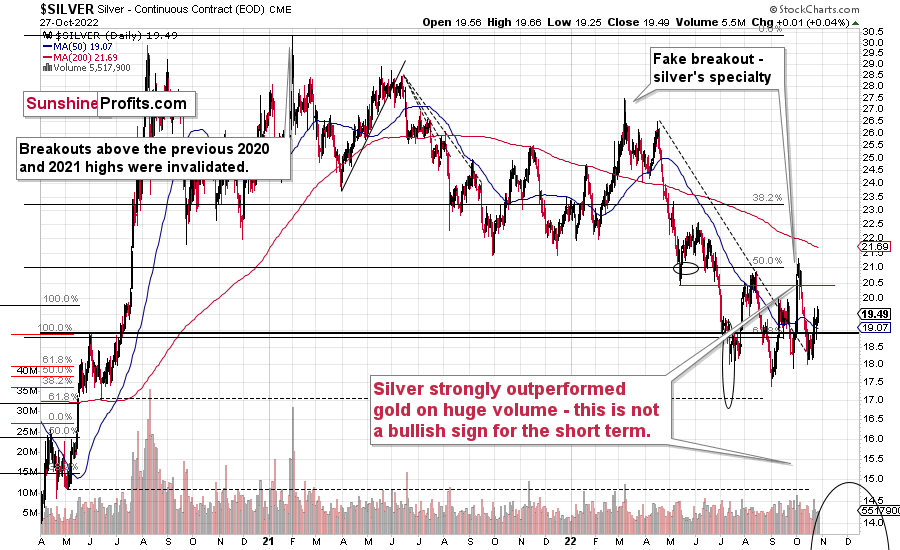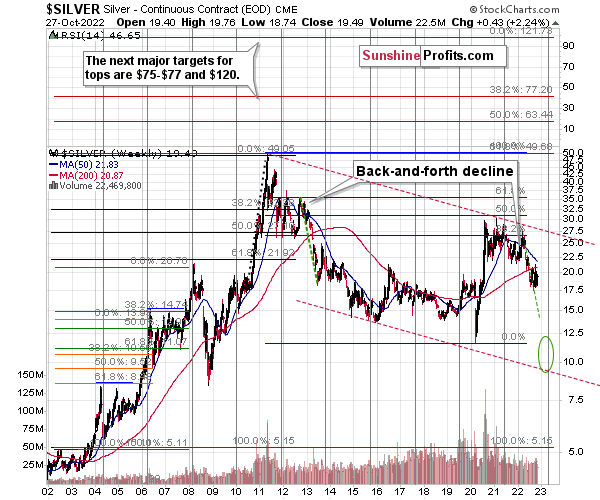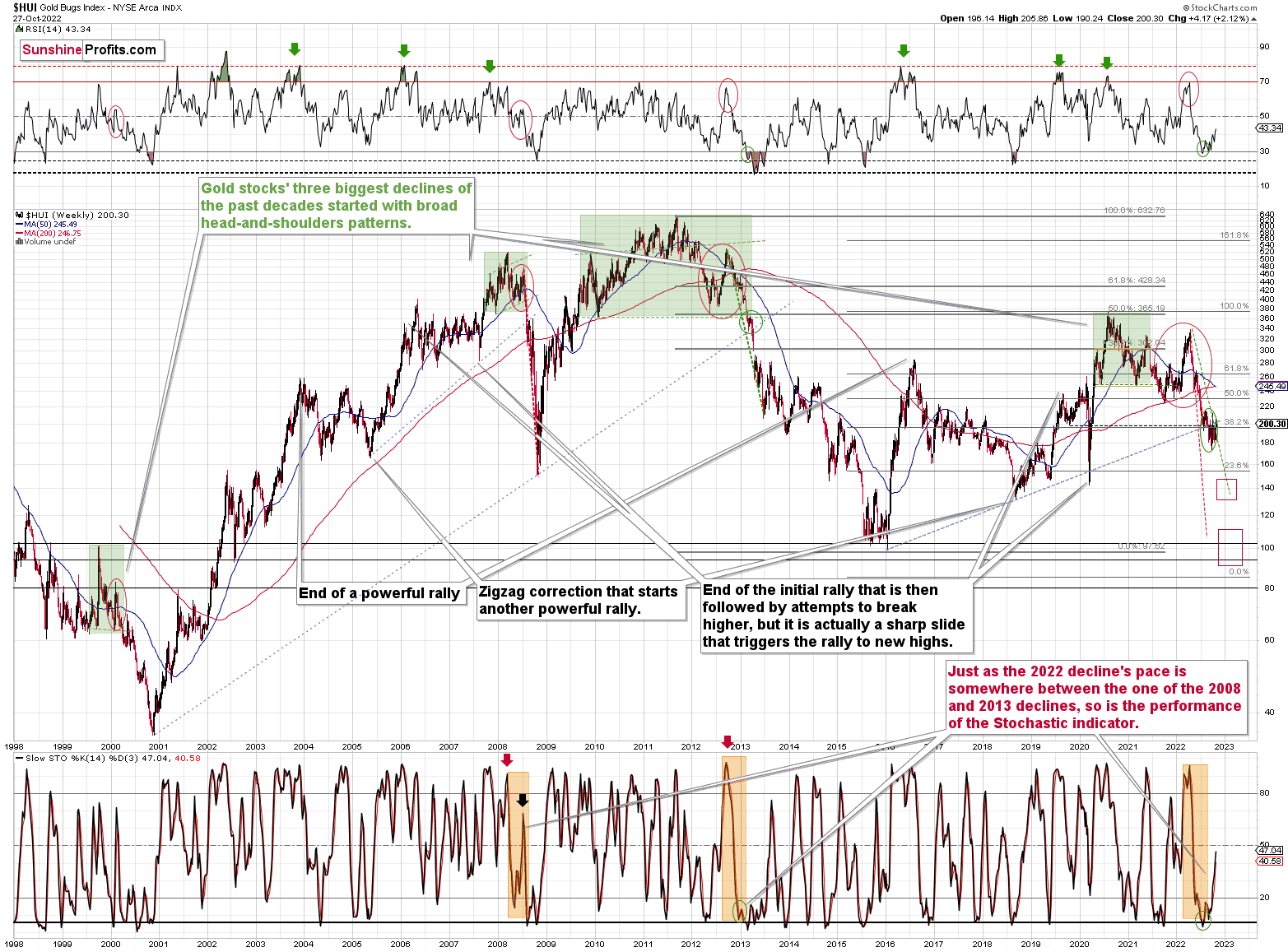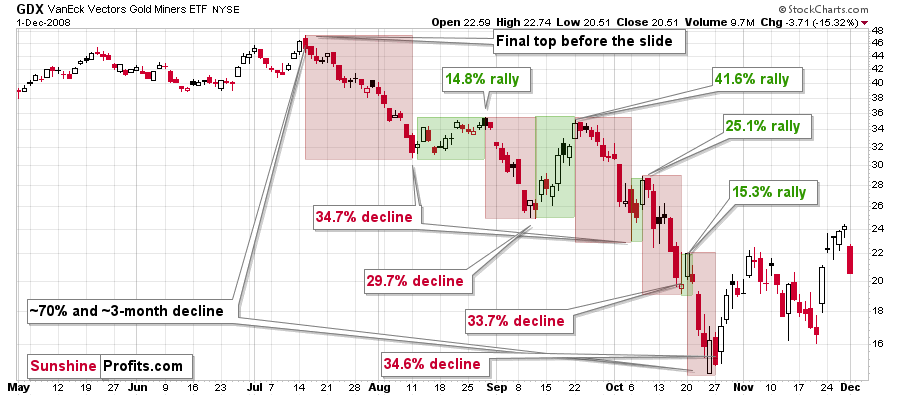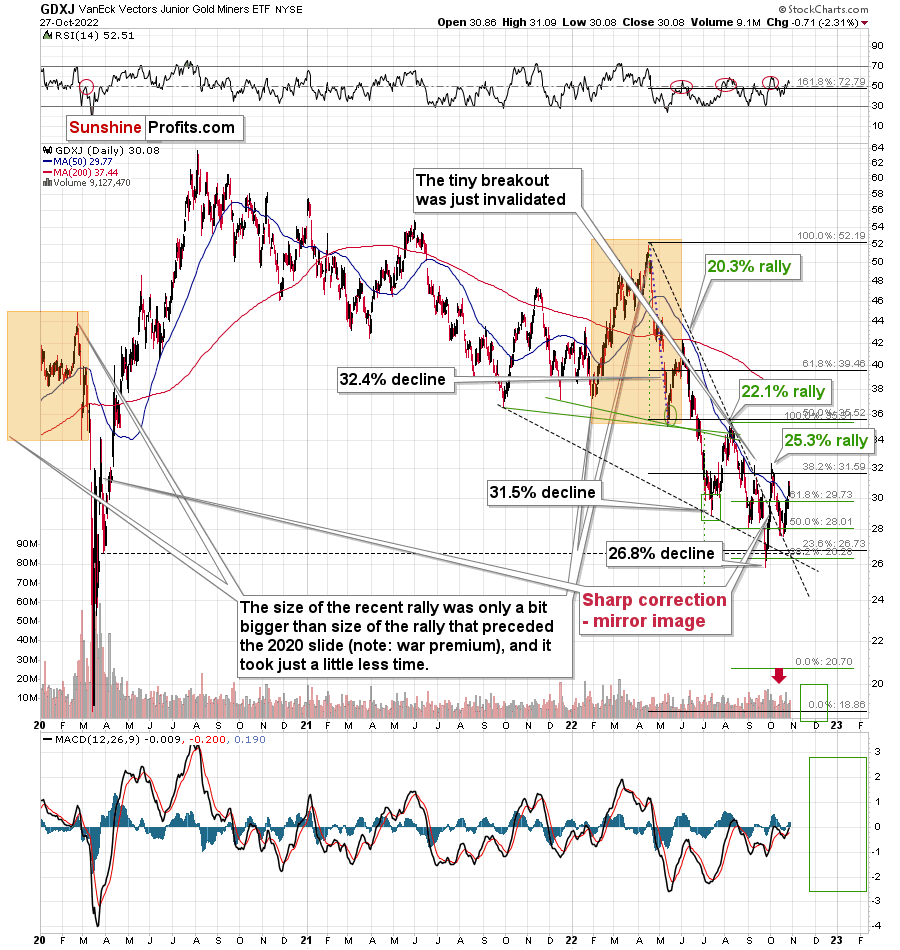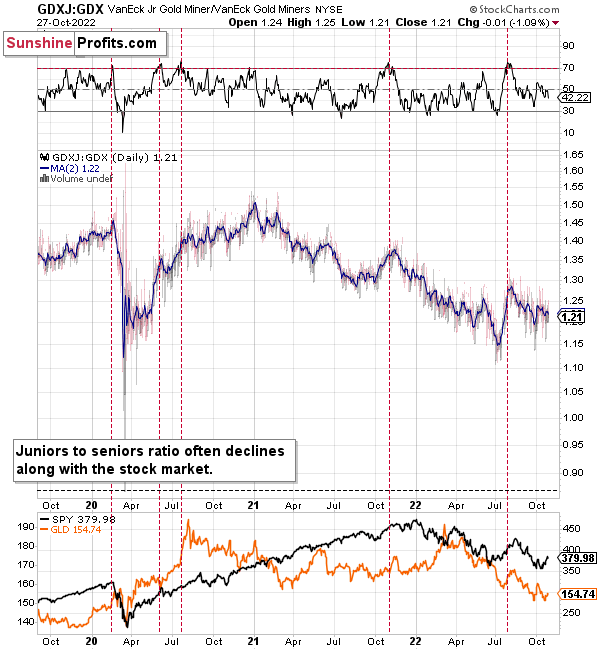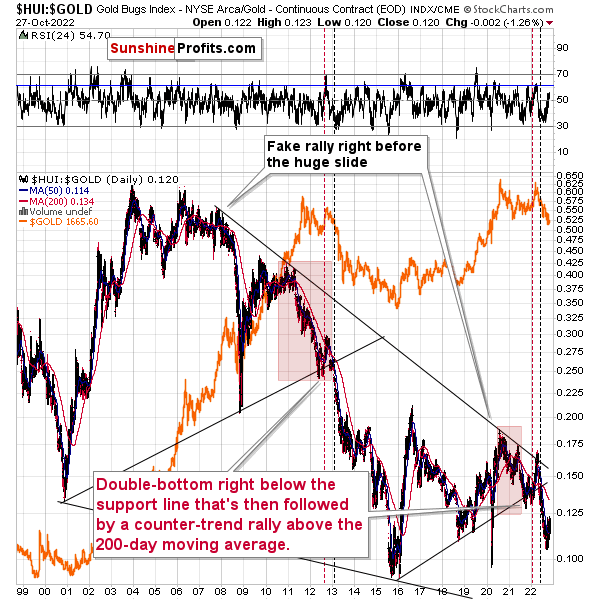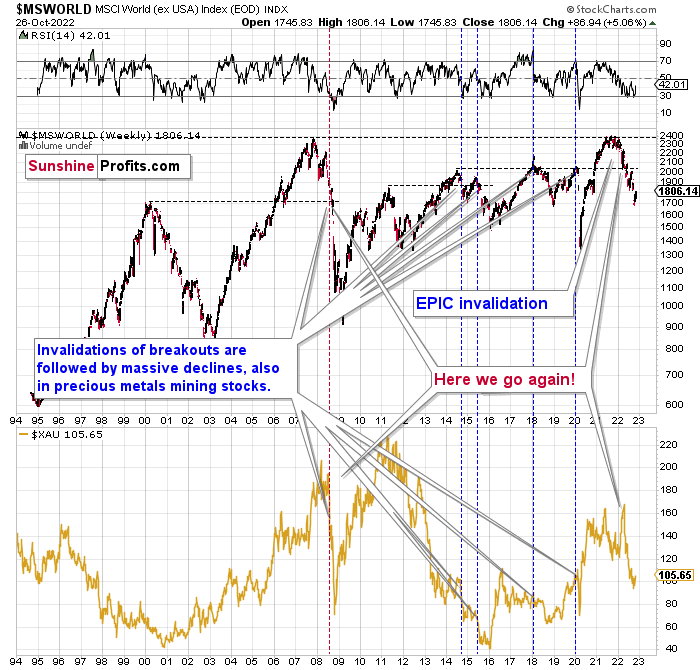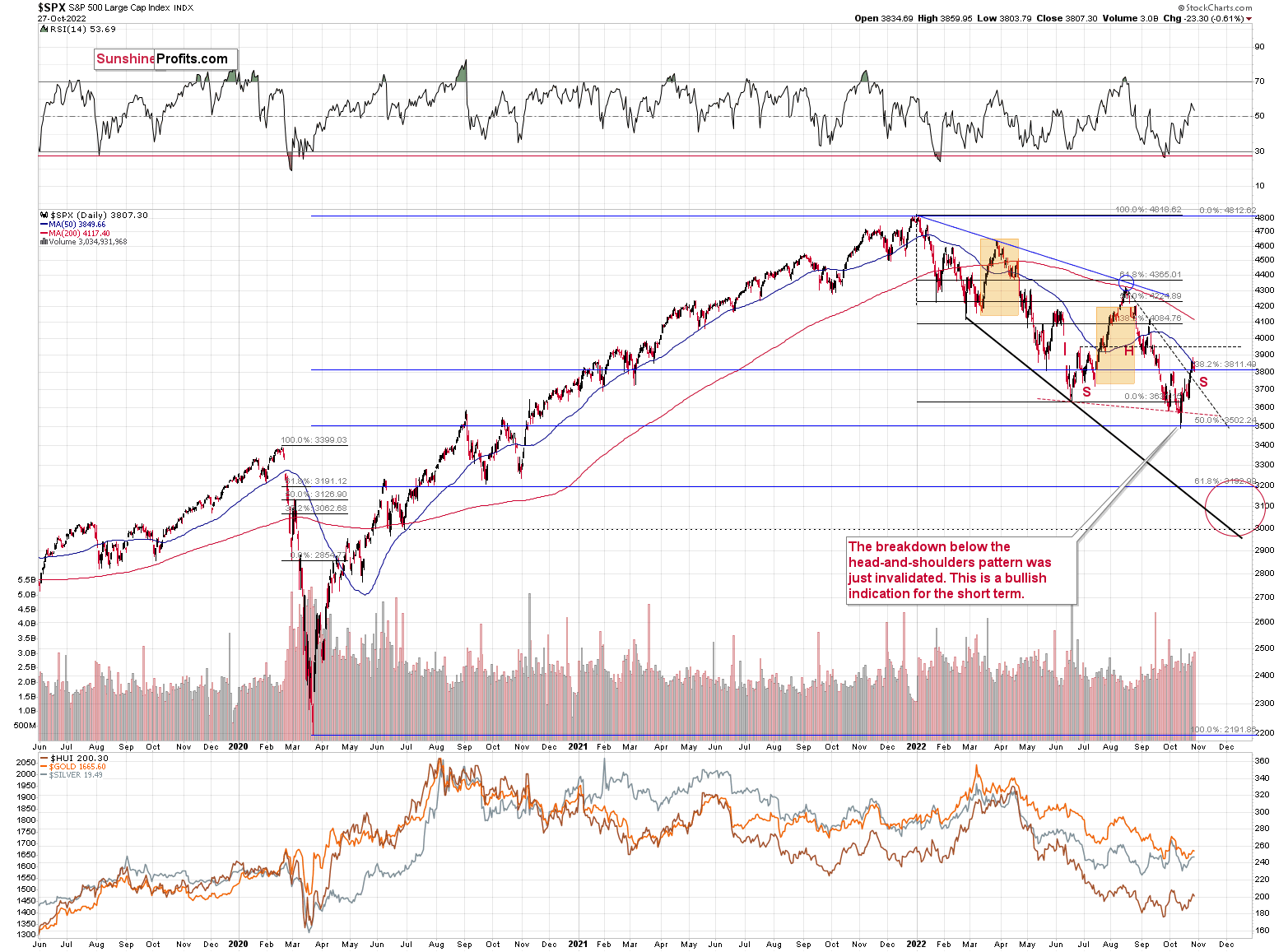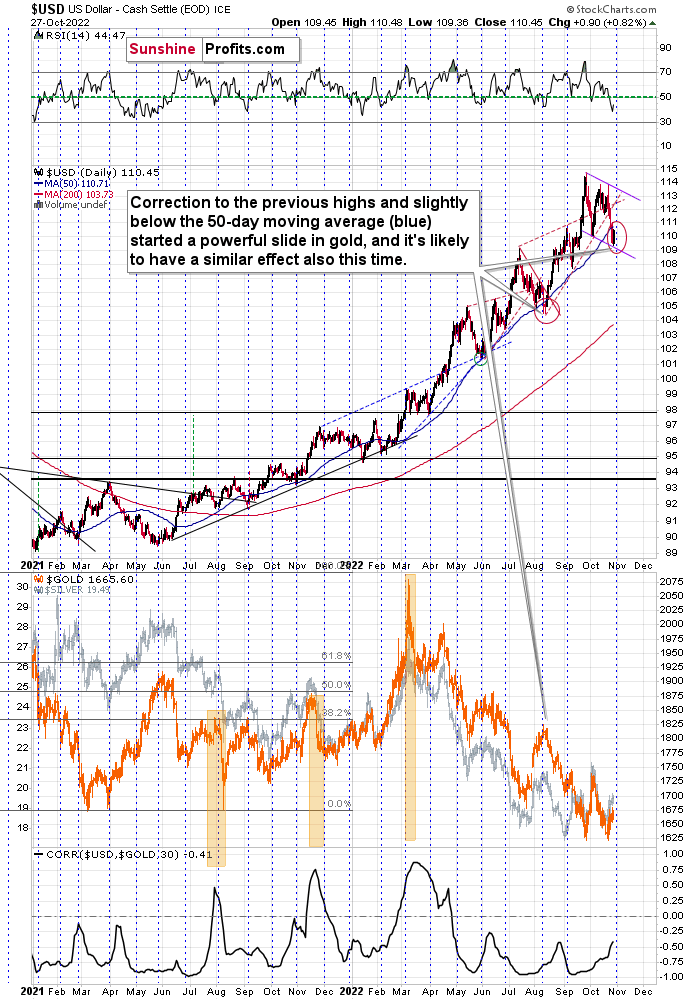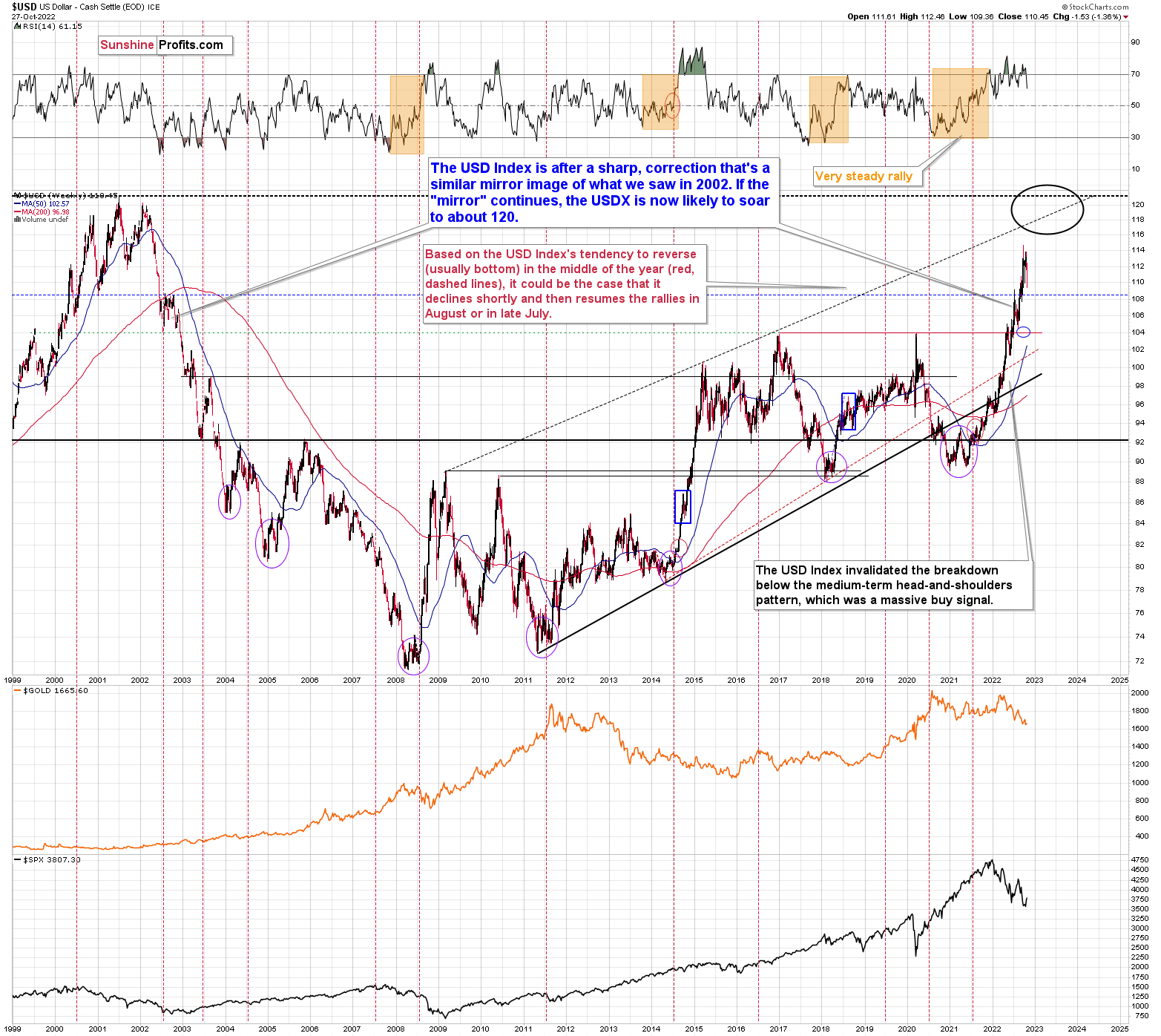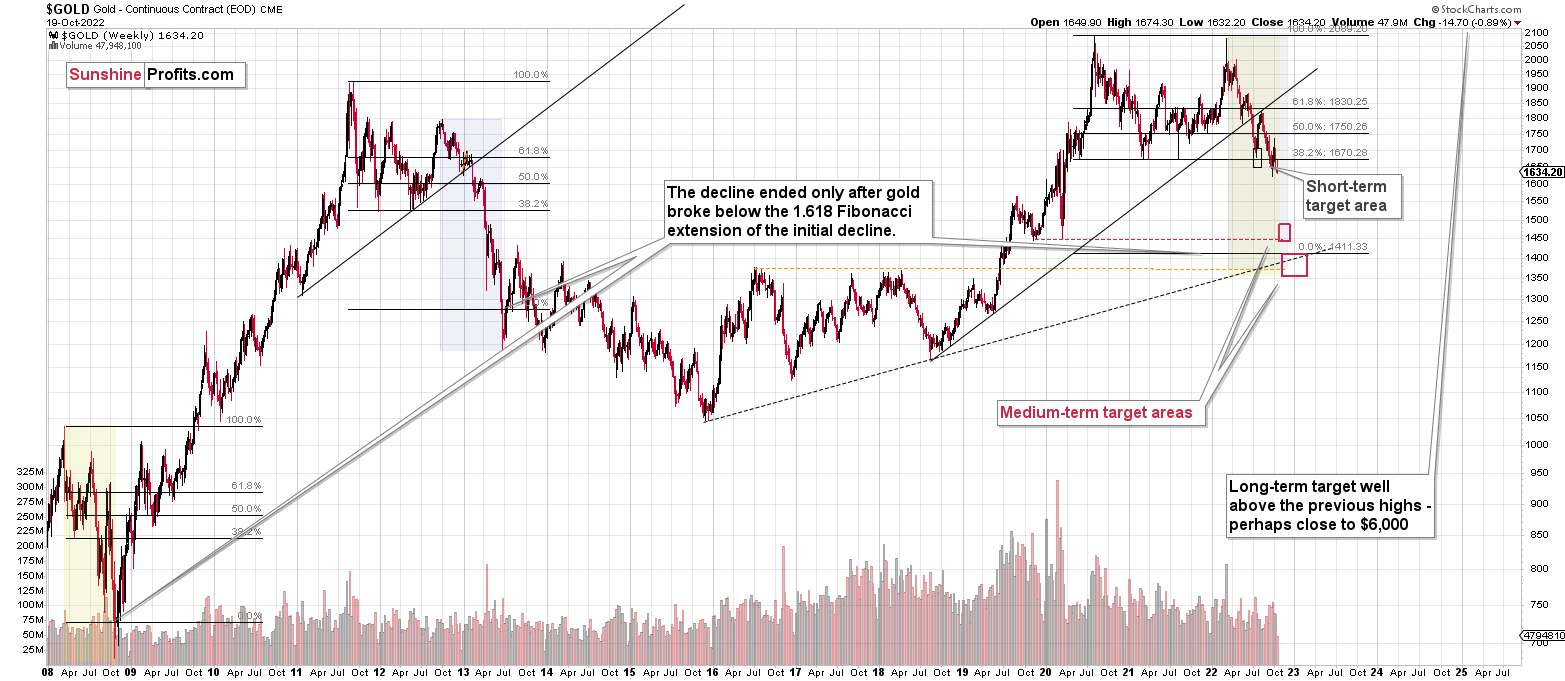Briefly: gold and the rest of the precious metals market are likely to decline in the next several weeks/months and then start another powerful rally. Gold’s strong bullish reversal/rally despite the USD Index’s continuous strength will likely be the signal confirming that the bottom is in.
Welcome to this week's flagship Gold & Silver Trading Alert. Predicated on last week’s price moves, our most recently featured outlook remains the same as the price moves align with our expectations. On that account, there are parts of the previous analysis that didn’t change at all in the earlier days, which will be written in italics.
The key thing that we saw since I posted the previous flagship analysis (on Oct. 20) is that quite a lot happened, but almost nothing changed. At least with regard to the outlook for the precious metals market. On Oct. 20, gold futures closed at $1,656.30, and at the moment of writing these words, gold futures are trading at $1,650.95.
Let’s start today’s analysis with a recap of what recently happened on the fundamental front.
The Weekly Fundamental Roundup
With bear market rallies, Big Tech bloodbaths and false narratives dominating the headlines this week, the rollercoaster ride helped support gold, silver and mining stocks. However, with fundamental reality proving problematic in recent days, the optimism has come under immense pressure. To explain, I wrote on Oct. 19:
Positioning, sentiment and seasonality support a higher S&P 500, while the medium-term technicals and fundamentals are profoundly bearish. Thus, we consider any strength a bear market rally and expect the index to hit lower lows in the months ahead. However, since asset prices don't move in a straight line, the setup is tactically bullish.
Then, after Alphabet (Google) and Microsoft plunged following poor earnings performances, I noted on Oct. 26 that sentiment can only uplift risk assets for so long. I wrote:
With two of the four largest companies in the S&P 500 suffering, the squeeze may have already run its course. Moreover, while positioning is still heavily short, the index offered tactical value near 3,600, not 3,850.
In addition, with the bearish medium-term fundamentals rearing their ugly head, and the Fed poised to raise interest rates by 75 basis points next week, stocks offer a poor risk-reward proposition when the U.S. federal funds rate (FFR) should hit 4%.
To that point, with Meta Platforms (Facebook) – which was one of the largest companies in the S&P 500 – imploding during the cash session on Oct. 27, the tech wreck intensified.
Please see below:
Also, with Amazon – the third largest company in the S&P 500 – sinking after hours on Oct. 27, the earnings bloodbath has Big Tech singing the blues.
Please see below:
So while the GDXJ ETF fell by 2.31% on Oct. 27 and underperformed the S&P 500, Big Tech has essentially erased the risk-on sentiment. Therefore, gold, silver and mining stocks should come under more pressure if the S&P 500 cracks. Furthermore, while the index’s medium-term outlook is profoundly bearish, short covering could keep the S&P 500 from hitting fresh lows in the near term. However, a new bearish milestone should materialize in the months ahead.
Digging the Dollar
With the USD Index regaining its swagger on Oct. 27, the dollar basket reversed some of its recent weakness. Moreover, with the shift occurring right on cue, I noted earlier in the day that support was near. I wrote:
The candlestick chart above tracks the USD Index, while the black line at the top tracks its 75-day moving average. If you analyze the relationship, you can see that the 75-day MA has provided material support for the last ~16 months. Likewise, it roughly marked the bottom during the July/August pullback.
As a result, with the level fast approaching, it should help the greenback regain its footing. In addition, the USD Index’s daily RSI (the red line at the bottom) is near the levels that coincided with reversals over the last ~16 months. Thus, we may witness a comeback sooner rather than later.
Furthermore, while the European Central Bank (ECB) hiked interest rates by 75 basis points on Oct. 27, the EUR/USD sold off as reality re-emerged; and since the currency pair accounts for nearly 58% of the USD Index’s movement, its performance is material.
Please see below:
To explain, the candlestick chart above tracks the one-minute movement of the EUR/USD. As you can see, the currency pair dumped, pumped, and then sunk to daily lows after the ECB’s announcement. As a result, a ‘buy the rumor, sell the news’ event was on full display.
So while the EUR/USD has suffered mightily in 2022, non-commercial (speculative) futures traders are still net-long the euro, which leaves plenty of room for positioning to decline.
Please see below:
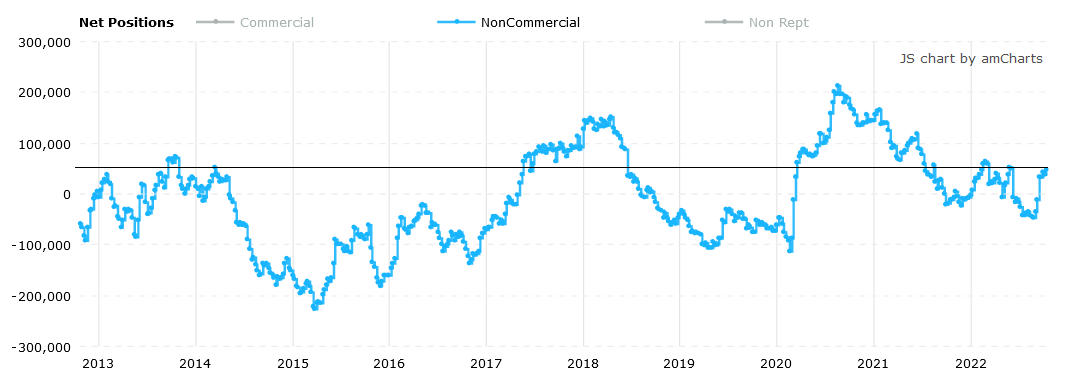 Source: Commitments of Traders (COT) report
Source: Commitments of Traders (COT) report
To explain, speculators were net long ~48,000 contracts as of Oct. 18; and while net shorts hit 100,000+ contracts in 2016, 2019 and 2020, and 200,000+ in 2015, the crowd is still bullish on the euro. However, material EUR/USD downside could emerge if investors press the shorts like they did from 2015 to 2020.
Also noteworthy, the USD Index confronts a bullish seasonal backdrop that supports higher prices in November.
Please see below:
To explain, the black circles above show how the USD Index often outperforms from roughly mid-October to late November. As such, while the greenback's ascent was delayed somewhat, seasonality and stock market stress create a bullish backdrop.
To that point, 20 years of data show that the USD Index realizes an average return of 0.4% in November and rallies 60% of the time; and with only May offering better metrics at 0.5% and 60%, respectively, the USD Index should have the wind at its back next month.
What Inflation?
With Q3 earnings season in full swing, S&P 500 companies continue to shed light on the macroeconomic backdrop; and with inflation still highly problematic, the developments are bullish for the U.S. federal funds rate (FFR), real yields and the USD Index.
For example, McDonald’s – the largest restaurant chain in the world – released its third-quarter earnings on Oct. 27. CFO Ian Borden said during the Q3 conference call:
“Company-operated margins remain pressured by significant commodity and wage inflation as well as elevated energy costs. We believe these pressures will continue to impact margins for the next several quarters.”
He added:
“There are lessons from 2008-2009, but there are also differences from 2008-2009…. We're in a different dynamic right now. You have not just pressure on inflation with food and paper, but you've also got labor inflation in a very tight labor market. So that's different than 2008-2009. Our expectation is that we are going to perform well in this environment, certainly on a relative basis to our competitors here, but there are different factors at play.”
As a result, with “significant commodity and wage inflation” eliciting a rise in menu prices, McDonald’s continues to price its products ahead of the Consumer Price Index (CPI).
Please see below:
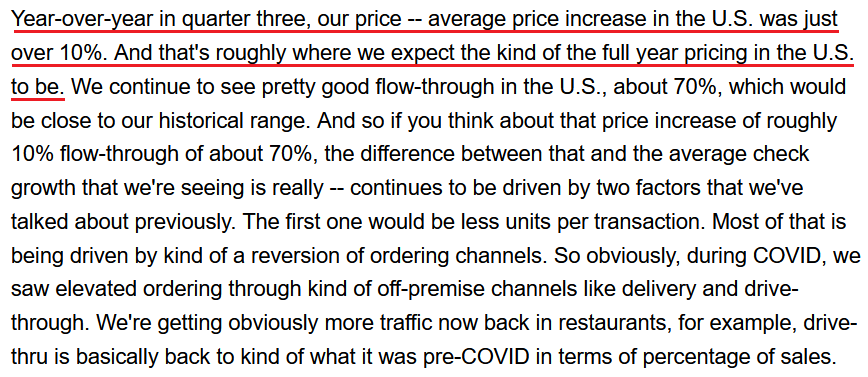 Source: McDonald’s/Seeking Alpha
Source: McDonald’s/Seeking Alpha
Likewise, Chipotle Mexican Grill – which has a more than $40 billion market cap – released its third-quarter earnings on Oct. 25. CFO Jack Hartung said during the Q3 conference call:
“Earlier this month, we took a price increase in around 700 restaurants to address pockets of outsized wage inflation. Menu prices in each restaurant increased between 2% and 3%, which had a company-wide impact of about 0.5% overall. The benefit of menu price increases offset elevated costs across the board.”
Thus, like McDonald’s, Chipotle Mexican Grill’s menu prices are also outperforming the CPI.
Please see below:
 Source: Chipotle Mexican Grill/Seeking Alpha
Source: Chipotle Mexican Grill/Seeking Alpha
So, while the Bank of Canada’s (BoC) relatively dovish 50 basis point rate hike may spur optimism that the Fed could follow suit, North American central banks are far from achieving their inflation targets; and with corporations continuing to price their products aggressively, the BoC, and possibly the Fed, materially underestimate the challenges that lie ahead.
The Bottom Line
While sentiment, positioning, seasonality and pivot hopes helped uplift the S&P 500, earnings destruction spoiled the party. Moreover, if the fundamental devastation depresses sentiment and resilient inflation dashes pivot hopes, it could be a long way down before the S&P 500 finds a medium-term bottom. Therefore, while short covering helps cushion the blow when sell-offs occur, gold doesn’t have that luxury since speculators are net long the yellow metal.
In conclusion, the PMs were mixed on Oct. 27, as silver nudged above the flat line. However, with the GDXJ ETF materially underperforming the S&P 500 and its precious metals peers, the junior miners confront a treacherous medium-term backdrop. As a result, we remain bearish and expect the PMs to hit new lows in the months ahead.
What to Watch for Next Week
With more U.S. economic data releases next week, the most important are as follows:
- Oct. 31: Dallas Fed manufacturing and Chicago PMIs
The regional surveys cover the economic outlooks in their respective regions, but they help paint a complete portrait of employment, inflation and growth.
- Nov. 1: ISM and S&P Global manufacturing PMIs, Dallas Fed services PMI, JOLTS job openings
S&P Global and the ISM’s nationwide manufacturing surveys provide key insights into growth, employment and inflation. As such, they lead future government data. Furthermore, the Dallas Fed’s services report will augment its manufacturing survey, while the JOLTs results will provide a lagged look at U.S. employment opportunities.
- Nov. 2: FOMC meeting, Jerome Powell press conference, ADP nonfarm employment report
The FOMC meeting will garner all the attention, as the Fed could pull a BoC and be less hawkish than expected. However, the important clues will come during Powell’s presser. In addition, ADP’s payroll data will shed more light on the U.S. labor market.
- Nov. 3: Challenger job cuts, ISM and S&P Global services PMIs
S&P Global and the ISM’s services PMIs will complement their manufacturing surveys, while Challenger will note the number of layoffs that occurred in October.
- Nov. 4: U.S. nonfarm payrolls, unemployment rate, average hourly earnings, labor force participation rate.
While all four metrics are interrelated, it’s paramount to monitor the strength of the U.S. labor market and wage inflation to determine the Fed’s next move.
All in all, economic data releases impact the PMs because they impact monetary policy. Moreover, if we continue to see higher employment and inflation, the Fed should keep its foot on the hawkish accelerator. If that occurs, the outcome is profoundly bearish for the PMs.
Technically Speaking
Let’s start today’s technical discussion with a quick check on copper prices.
Practically, everything that I wrote about it last week (and in the previous weeks/months) remains up-to-date:
Copper recently CLEARLY invalidated another attempt to move above its 2011 high. This is a very strong technical sign that copper (one of the most popular commodities) is heading lower in the medium term.
It seems to me that there might be some kind of smaller corrective upswing or a pause when copper moves to about $3.0, but that it would then decline profoundly once again, only to bottom in the $2.0-2.4 area. That’s where we have rising, long-term support lines and also the previous – 2016 and 2020 – lows.
Interest rates are going up, just like they did before the 2008 slide. What did copper do before the 2008 slide? It failed to break above the previous (2006) high, and it was the failure of the second attempt to break higher that triggered the powerful decline. What happened then? Gold declined, but silver and mining stocks truly plunged.
Again, copper is after invalidation of a major breakout, a decline, the initial correction, and its decline just accelerated. Copper prices currently SCREAM that it’s 2011 or (more likely) 2008 all over again. This is extremely bearish for mining stocks (especially juniors) and silver.
No market moves in a straight line, up or down, but since we just saw a corrective upswing, the downtrend might now resume.
Based on the recent short-term move lower, it seems that the downtrend has already resumed.
Having said that, let’s check junior miners’ really big picture.
I previously commented on the above chart in the following way:
The Toronto Stock Exchange Venture Index includes multiple junior mining stocks. It also includes other companies, but juniors are a large part of it, and they truly plunged in 2008.
In fact, they plunged in a major way after breaking below their medium-term support lines and after an initial corrective upswing. Guess what – this index is after a major medium-term breakdown and a short-term corrective upswing. It’s likely ready to fall – and to fall hard.
So, what’s likely to happen? We’re about to see a huge slide, even if we don’t see it within the next few days.
Having said that, let’s turn to gold.
Let’s start with context:
Between 2020 and now, quite a lot happened, quite a lot of money was printed, and we saw a war breaking out in Europe. Yet, gold failed to rally to new highs.
In fact, it’s trading very close to its 2011 high, which tells you something about the strength of this market. It’s almost absent.
Truth be told, what we see in gold is quite in tune with what we saw after the 2011 top, and in particular, shortly after the 2012 top. The long-term gold price chart below provides details.
Basically, the key thing about gold’s long-term chart is that it doesn’t show any important changes. The downtrend continues in tune with the 2013 price action, and the very recent rally is barely visible.
To clarify, it is visible, but what’s visible is still in tune with the final attempt for gold to rally in April 2013, right before the biggest part of the slide.
Gold is sometimes forced to react to some geo-political events as the safe-haven buying kicks in, but these moves are usually short-term lived. Looking at long-term charts helps to keep things in proper perspective.
Consequently, my previous comments remain up-to-date:
Based on the above chart, it’s quite clear that the situation that is now being repeated. The patterns marked with orange rectangles and blue ellipses are almost identical (also in the MACD indicator, and to a lesser extent in the RSI indicator).
Sure, the situations are not identical, as this time we had a Russian invasion of Ukraine that pushed gold temporarily higher. Other than that, the situations are extremely similar.
Based on the stage of the self-similarity and the confirmed breakdown below the $1,700 level, gold is now likely to slide.
Based on the analogy to 2013, it’s not only likely to slide, it’s likely to slide profoundly in a sharp manner. These may be the last days or hours before the slide fully begins.
How low is gold likely to go during this upcoming decline? Perhaps as low as its 2020 low – to the $1,450-1,500 area.
I realize this is far from the current price, but nonetheless, this target area appears justified in my opinion. There are two important Fibonacci retracements based on the 2015-2020 rally that gold can bounce from (it recently bounced from the 38.2% retracement). These are 50% and 61.8% retracements.
The support provided by the 61.8% retracement is strengthened by the 2020 low and the support provided by the 50% retracement is strengthened by the 2019 high.
However, based on gold’s self-similarity to 2013, it seems that we’re about to see a slide that’s bigger than what we’ve been seeing so far this year. This time – based on the similarity – gold is likely to decline profoundly, but no longer in the back-and-forth mode. If gold formed its next local low at the 50% retracement (so at about $1,560), then it might do so still within the declining, short-term trend channel (sometime in September).
However, if gold is to stick to the link to 2013, then it should decline more rapidly. In this case, the technique that can help us estimate the short-term target is the one that says that after a breakdown from a trend channel, price is likely to move approximately by as much as the height of the previous trend channel. In this case, gold could break below the trend channel soon and then decline even more. Based on the height of the trend channel, the above means that a move to the 61.8% retracement as the next downside target is more likely than a move to the 50% retracement.
I previously wrote that the above-mentioned decline in gold would likely be linked to a breakdown in the EUR/USD below 1, and we already saw both: decline in gold, and a breakdown in the EUR/USD below 1. The implications remain bearish.
Let’s zoom in on what happened in 2013 after the analogous rebound.
Well, gold consolidated for a few weeks and plunged only after that consolidation.
That’s what we saw recently as well. Of course, we haven’t seen the big plunge yet, but the other parts of the recent price patterns are very, very similar to what we saw in 2013.
Still, let’s keep in mind that history doesn’t necessarily repeat itself to the letter – it rhymes. Consequently, it’s quite possible to have two corrections from the previous lows instead of just one.
Especially if the temporary (!) effect of geopolitical events practically forces gold to move up due to safe-haven demand.
In other words, on a more-or-less basis, gold is doing exactly what it’s been doing in April 2013, right before the biggest part of the slide.
This time, gold is making a few attempts to break lower, as geopolitical news and rumors keep popping up. However, all they are able to trigger are rebounds, and those rebounds are getting smaller each time. This is a bearish confirmation, as it tells us that the bulls’ strength and buying power are drying up. And when they finally do give up, and the decline starts, there will be many people that are able to sell (after all, they had just bought recently), thus contributing to the decline’s volatility.
Having said that, let’s zoom in to see gold’s short-term price moves.
The above chart shows in greater detail what I already wrote above – the rebounds are getting smaller. It seems that at some point, all the market would get (assuming there was yet another bullish piece of news / rumor) is an intraday upswing.
On the other hand, a single bearish piece of news / rumor that surprises the market could trigger waterfall selling and a decline that’s similar to what we saw in 2013.
That’s exactly how the markets can remain self-similar and overall technical while reacting to news on a day-to-day basis.
All kinds of news hit the markets on a daily basis. The more important ones are less frequent, but there are myriads of detailed, less important announcements made each day. Sure, gold will react to bullish news by rallying, and it will likely react to bearish news by declining. BUT, how MUCH will the market move given a certain piece of news / rumor is a completely different manner?
Imagine something bullish happening. Should gold rally by $5? Or $15? Or $75?
It’s impossible to tell!
If something bearish happens, should gold decline by $5? Or $15? Or $75?
Again, it’s impossible to tell – that is, if you’re looking at fundamentals alone.
However, if you know – beforehand – what the market is likely to do, then you can expect it to mostly ignore news / rumors that are against what the market “wants” to do, and that the reaction to whatever is in tune with what the market “wants” to do (technical reasons) will be amplified. So, while on a day-to-day basis, it might seem like gold is following the news, it’s just that, once you zoom out, it becomes obvious that it actually does what it’s been doing under similar circumstances in the past.
Right now, gold continues to repeat its 2013 performance, which has extremely bearish implications for the coming weeks.
Having said that, let’s take a look at the silver market.
Two weeks ago, I commented on the above silver chart in the following way:
Just like gold, silver reversed, and just like it’s the case with gold, I’m not buying the supposedly bullish narrative here. I don’t think anything more than a brief rebound is likely and it’s quite possible that there will actually be no additional rally – silver is down by almost 1% so far in today’s pre-market trading.
Silver’s slide from above $21 to below $19 has been very sharp, so it’s natural to see some sort of breather. It doesn’t necessarily have to be bullish.
When in doubt, take a step back and think about what really changed. And, well, nothing changed. Real rates are still going to move higher. The situation, being as bad as it is on many levels, is still better than the situation (in monetary / fiscal terms that is) in the Eurozone and Japan. Consequently, the USD Index has good reasons to strengthen.
Since real rates and the USDX are the main fundamental drivers for gold, and the technicals for gold continue to support the medium-term downtrend’s continuation, the big surprises for the precious metals sector are likely to be to the downside. The pace at which silver has declined recently appears to confirm that.
[The above was about the sharp early-October rally]
Indeed, silver declined profoundly. It moved much lower, practically erasing its recent rally. No wonder – the rally was based on an unfounded expectation of Fed’s dovish U-turn, which is unlikely to happen anytime soon.
What’s next?
Well, what happened next was another rally, based on similarly dovish expectations. However, it was nowhere close to being as big as the preceding one that was based on similar premises. This time, silver didn’t manage to move above its Sep. highs. It’s also down to almost $19 in today’s (Oct. 28) pre-market trading.
This tells us two things.
First, that bulls’ buying power might have dried up or almost dried up because this time, the fundamental reasoning for a dovish U-turn was stronger (it’s not likely to happen in my view, but the reasoning for a softening of the Fed’s approach was indeed more reasonable this time), and yet the market didn’t respond as positively.
Second, the local top might already be in.
Let’s keep in mind that the entire July-now period can be viewed as one big flag pattern, and those “continuation patterns” tend to be followed by moves that are similar to the ones that preceded them.
In this case, the move that preceded the flag was a decline from about $28. This means that another move lower in silver is likely to be huge.
Once silver breaks below its 2022 lows, it has little support all the way until its 2020 low. There’s support just below $15, but it’s not very strong, so it might not trigger anything more than a brief correction.
Let’s keep in mind that while gold is repeating its 2013 performance, so is silver.
As you can see on the above chart, silver corrected about 50% of the previous downswing, and this correction ended at about $30, a long time ago. Ever since, silver has been declining, and even the outbreak of war in Europe didn’t make silver rally above that level.
On the above chart, you can see how silver first topped in 2011, then declined and formed another top at the cyclical turning point. Next, it declined once again – to the previous lows. After that, silver rallied (in 2012 and 2022), and it topped between its 50-week moving average (marked in blue) and the previous top. Now silver is declining in a back-and-forth manner (you can see it more clearly on the previous short-term silver chart).
Back in 2012, these were just the early days of a gargantuan decline, and the same appears likely to be the case this time. Interest rates are going up after all, and the Fed is determined to quench inflation.
Let’s not forget that rising interest rates are likely to negatively impact not just commodities, but practically all industries. This will likely cause silver’s price to decline profoundly, as silver’s industrial demand could be negatively impacted by lower economic growth (or a decline in economic activity).
Besides, please note that silver didn’t even manage to rally as much as copper (which tried to move to new highs recently) or most other commodities, thus being rather weak.
Consequently, it seems that silver will need to decline profoundly before it rallies (to new all-time highs) once again.
Having said that, let’s take a look at what happened in mining stocks.
History tends to repeat itself. Not to the letter, but in general. The reason is that while economic circumstances change and technology advances, the decisions to buy and sell are still mostly based on two key emotions: fear and greed. They don’t change, and once similar things happen, people’s emotions emerge in similar ways, thus making specific historical events repeat themselves to a certain extent.
For example, right now, gold stocks are declining similarly to how they did in 2008 and in 2012-2013.
As gold was practically forced to rally recently based on geo-political events, news, and rumors, so were gold stocks.
Did it change anything technically?
Not really.
The verification of the breakdown below the rising, long-term support line simply continued. The fact that we haven’t seen a profound slide yet, but verifications’ continuation, doesn’t change the likelihood of seeing the former soon.
In fact, gold stocks’ inability to break back above the rising support/resistance line despite bullish news / rumors tells us that the market really does want to move lower from here, not higher.
Since the analogies to 2013 and 2008 were not invalidated because of this upswing, my previous comments on the above chart remain up-to-date:
The key analogies in the case of the HUI Index (I’m using this chart as it has the most long-term scope) are to 2008 and 2013.
In 2008, there was a move higher in the stochastic that accompanied a sharp – but temporary – upswing that was then followed by a much bigger decline.
In 2013, there was a series of tiny upswings that didn’t really change anything.
Right now, we see something in between the above.
On multiple occasions, I wrote that the situation right now is somewhat similar to what we saw in 2013 (mostly), but it also has a 2008 vibe to it.
Even so, the pace at which gold stocks are declining is between both declines: the 2008 and 2013 ones. I marked this with dashed lines.
Please note the green, dashed line that starts at the late-2012 top and the one that starts at the 2022 top. Those lines are identical. You can see that back in 2012 and 2013, the HUI Index traded above this line. This time, it’s trading below it – gold stocks are declining faster.
Faster declines imply sharper corrections – as emotions get hotter.
So, does Stochastic’s performance indicate an even bigger rally here? Not necessarily.
Was the current rally very likely based on stochastic? Possible – yes, but very likely – no. The link to 2013 is still more visible and more important.
How low can the HUI Index fall during the next big downswing?
As it’s the case with gold and silver, a move back to the 2020 lows is definitely in the cards. Please note that this level is also strengthened (as support) by other major lows: the 2019, 2014, and 2008 ones.
However, I wouldn’t rule out a move even lower on a temporary basis. If gold were to decline to about $1,450-1,500, it would mean that it would double its current 2022 decline. If the HUI Index does that, it will move below 150.
So, all in all, 120-150 is my current target area for the upcoming slide in the HUI Index.
All right, let’s zoom in and see how mining stocks declined in 2008.
Back then, the GDXJ ETF was not yet trading, so I’m using the GDX ETF as a short-term proxy here.
The decline took about 3 months, and it erased about 70% of the miners’ value. The biggest part of the decline happened in the final month, though.
However, the really interesting thing about that decline – that might also be very useful this time – is that there were five very short-term declines that took the GDX about 30% lower.
I marked those declines with red rectangles. After that, a corrective upswing started. During those corrective upswings, the GDX rallied by 14.8-41.6%. The biggest corrective upswing (where GDX rallied by 41.6%) was triggered by a huge rally in gold, and since I don’t expect to see anything similar this year, it could be the case that this correction size is an outlier. Not paying attention to the outlier, we get corrections of between 14.8% and 25.1%.
Fast forward to the current situation. Let’s take a look at the GDXJ ETF.
Right now, we are after three declines that took the GDXJ about 30% lower.
If history is to repeat itself to the letter, then we can expect to see two more big slides. Of course, they don’t have to be limited to just 30%. The GDXJ could slide much lower in each case.
For example, a quick slide to 2020 lows (slightly below $20) would be in perfect tune with the above – as a single decline. We could then see a rebound, and another powerful slide.
That’s what seems most likely in my view – at least from the medium-term point of view.
As far as the recent short-term developments are concerned, then the thing that I would like to emphasize is that they don’t change the bearish outlook – at all.
The only thing that we really saw was another GDXJ’s attempt to rally above its 50-day moving average. This attempt didn’t fail based on yesterday’s closing prices, but given today’s decline in GDXJ’s London trading (by ~3.5%), it’s quite likely that this attempt will be invalidated shortly – quite likely today.
Each previous attempt to rally above the 50-day MA failed (since April, that is) and it was followed by big declines. It also has bearish implications this time.
Additionally, please note that the RSI just jumped above 50, and ever since the April 2022 top, these levels in the RSI meant that local tops were in. I marked that with red ellipses in the upper part of the chart.
There’s also one additional factor explaining why this counter-trend bounce might be so volatile – that’s because the mirror image of this decline – the 2020 rally – also features a sharp correction around those price levels.
This time, the correction doesn’t have to be as big as the move that led to it was not as sharp.
Now, as you may recall, I previously had a downside target of about $26, but I ended up resigning from it. I continue to think that this decision was justified from the risk to reward point of view (given the data that we had available at that time), as there were previously corrective upswings, and it was not a no-brainer that we’re going to see a rebound also one more time.
However, as geopolitics came into play this time, the counter-trend rally has indeed materialized. Since it doesn’t make much sense to try to predict those near-term geopolitical events – the world is too unpredictable, it’s better to focus on the part of the picture where we can actually gain an extra edge over other market participants. That is recognizing trends and tendencies. Once the very short-term dust settles, the markets are likely to get back to their previous trends and surprise those who assume that short-term geopolitical events have a lasting impact on the markets. They don’t. If that was the case, gold would be above $2,000 at this time, as that’ where it soared based on the Russian invasion. Well, the war didn’t end, and yet gold is at about $1,700.
Indeed, the RSI appears to have topped in the area that I marked, just like it did twice earlier this year. It seems that the decline can now continue, regardless of the immediate-term performance.
At this point, you might be wondering why junior miners are not trading at their previous 2022 lows, just like gold is, and what does this “strength” mean.
In short, it’s most likely due to the stock markets’ performance. It rallied recently, and some of the bullishness spilt over to mining stocks. What does it imply?
Well, as the stocks are likely to slide, the small bullish impact is likely to turn into a huge bearish impact. And if stocks don’t slide, but rally instead, then juniors are still likely to decline more than gold and silver in percentage terms, but their decline would not be as dramatic in this case.
In my view, a decline in stocks is still the most likely outcome – and I think that junior miners will be affected to a great extent. And yes, this means that I expect (no promises, of course) that our profits on the short positions in junior mining stocks are going to soar in the coming weeks.
Meanwhile, the relative performance of junior miners compared to senior miners continues to deteriorate in a medium-term trend.
During this quick upswing, juniors rallied relative to seniors, but this is just a very short-term move that’s within a short-, and medium-term downtrends.
This implies bigger declines in the GDXJ in the future.
Also, let’s not forget about the forest while looking at individual trees. By that, I mean looking at how gold stocks perform relative to gold. That’s one of the major indications that the current situation is just like what we saw at the 2012 top.
The situation in the gold stock to gold ratio is similar to what we saw in late 2012 and early 2013. The HUI to gold ratio invalidated its first attempt to break lower (marked with red, dashed lines), but after a corrective upswing, it then broke lower more decisively. That’s what I marked using black, dashed lines.
Recently, we saw a quick upswing in the ratio, but that’s not a game-changer – even the biggest declines had quick corrections in the past.
If history is to rhyme, we’re about to see a profound decline. In fact, we’re likely already past its beginning.
Also, please note that the pattern that we currently see, which started in early 2016, is somewhat similar to what happened between 2003 and 2008.
Back in 2008, the breakdown from the consolidation resulted in sharply lower ratio values and much lower prices of gold stocks.
So, if the situation is analogous to 2012-2013, we’re likely to see a big decline in the following weeks/months, and if it’s analogous to 2008, we’re likely to see an enormous decline in the following weeks/months.
Declining stock prices would only add fuel to the bearish fire (after all, gold stocks are… just stocks) and that’s exactly what’s likely to happen.
The technical picture in the case of world stocks remains extremely bearish, and my previous comments on it were just confirmed.
After a brief pause, the freefall continues, just like in 2008. This has profoundly bearish implications for the mining stocks that declined severely back then.
Here’s what I’ve been writing about the above chart for quite a few weeks now:
World stocks have already begun their decline, and based on the analogy to the previous invalidations, the decline is not likely to be small. In fact, it’s likely to be huge.
For context, I explained the ominous implications on Nov. 30. I wrote:
Something truly epic is happening in this chart. Namely, world stocks tried to soar above their 2007 high, they managed to do so, and… failed to hold the ground. Despite a few attempts, the breakout was invalidated. Given that there were a few attempts and that the previous high was the all-time high (so it doesn’t get more important than that), the invalidation is a truly critical development.
It's a strong sell signal for the medium - and quite possibly for the long term.
From our – precious metals investors’ and traders’ – point of view, this is also of critical importance. All previous important invalidations of breakouts in world stocks were followed by massive declines in mining stocks (represented by the XAU Index).
Two of the four similar cases are the 2008 and 2020 declines. In all cases, the declines were huge, and the only reason why they appear “moderate” in the lower part of the above chart is that it has a “linear” and not a “logarithmic” scale. You probably still remember how significant and painful (if you were long, that is) the decline at the beginning of 2020 was.
All those invalidations triggered big declines in the mining stocks, and we have “the mother of all stock market invalidations” at the moment, so the implications are not only bearish, but extremely bearish.
World stocks have declined below their recent highs, and when something similar happened in 2008, it meant that both stocks and gold and silver mining stocks (lower part of the chart) were about to slide much further.
The medium-term implications for mining stocks are extremely bearish.
However, let’s get back to the short- and medium-term points of view.
Last week, I commented on the above chart in the following way:
Remember the rather big head-and-shoulders pattern that was recently invalidated?
Well, it wasn’t completed nor invalidated in closing price terms. This formation could therefore still be completed and followed by a profound decline – at least to 3,250.
Ideally, this formation should be symmetrical, and please note that the left shoulder was created by two local tops (June and July 2022). Consequently, the fact that we just saw two local tops (October 2022) makes the formation quite reliable – if it’s going to be completed.
Stocks declined yesterday, and the S&P 500 futures are down in today’s pre-market trading, so it could be the case that the next big move lower is already underway. In this case, S&P 500 would first complete the right shoulder of the formation, break below it, perhaps correct a bit to verify the breakdown, and then slide much lower.
What does it all mean?
In my opinion, it means that the short-term outlook for stocks is unclear with a bearish bias, the medium-term outlook for stocks remains bearish, and the short- and medium-term outlooks for junior mining stocks remain bearish. Even if we see some immediate-term strength in the latter, I think it will be very temporary.
It all remains up-to-date. The fact that stocks moved to new October highs doesn’t change anything. Stocks are still below their left-shoulder highs, which means that the H&S formation remains relatively symmetrical.
Yes, we saw a breakout above the declining resistance line, but since stocks moved a bit lower recently, perhaps this breakout will be invalidated soon. And let’s keep in mind that invalidations are strong sell signals.
As interest rates are likely to go up, the stock market is likely to go down – perhaps as low as 3,200 on a short-term basis – and then – after a correction – even lower.
Most interestingly, though, such a decline would likely have a devastating effect on the prices of mining stocks (especially junior mining stocks) and silver. There might be some impact on gold, too.
The above would also be in tune with an extra rally in the USD Index. After all, less competitive exports are not that favorable for the U.S. economy.
Back in August, USD’s correction to the previous highs and slightly below the 50-day moving average (blue) started a powerful slide in gold, and it's likely to have a similar effect this time as well.
This is particularly likely to also be due to the following:
- The USD Index corrected in a near-perfect zig-zag (ABC) manner, which is the most classical way for a market to correct.
- The turn of the month is almost here (only two sessions left in October), and the USDX tends to reverse (mostly from bottoms, at least recently) at those times. Perhaps the bottom is already in.
- Gold’s reaction to the most recent decline in the USD Index was much lower than what we saw before the August top. This tells us that gold really wants to decline here.
From the long-term point of view, the USD Index is currently rallying in approximately the mirror image of how it declined in 2002. Based on this, it seems that one shouldn’t be surprised by a rather quick move from the current levels to about 120 – USD Index’s long-term highs. Of course, the implications for the precious metals market are profoundly bearish.
This doesn’t rule out quick corrections along the way – those don’t interrupt the big, weekly/monthly moves at all, and they don’t break the analogy. This includes the recent downswing – it didn’t invalidate the bullish medium-term uptrend.
This is extremely bearish for gold and the rest of the precious metals sector.
Overview of the Upcoming Part of the Decline
- It seems to me that the corrective upswing is over, and that the next big move lower is already underway.
- If we see a situation where miners slide in a meaningful and volatile way while silver doesn’t (it just declines moderately), I plan to – once again – switch from short positions in miners to short positions in silver. At this time, it’s too early to say at what price levels this could take place and if we get this kind of opportunity at all – perhaps with gold prices close to $1,500 - $1,550.
- I plan to switch from the short positions in junior mining stocks or silver (whichever I’ll have at that moment) to long positions in junior mining stocks when gold / mining stocks move to their 2020 lows (approximately). While I’m probably not going to write about it at this stage yet, this is when some investors might consider getting back in with their long-term investing capital (or perhaps 1/3 or 1/2 thereof).
- I plan to return to short positions in junior mining stocks after a rebound – and the rebound could take gold from about $1,450 to about $1,550, and it could take the GDXJ from about $20 to about $24.
- I plan to exit all remaining short positions once gold shows substantial strength relative to the USD Index while the latter is still rallying. This may be the case with gold prices close to $1,400 and GDXJ close to $15 . This moment (when gold performs very strongly against the rallying USD and miners are strong relative to gold after its substantial decline) is likely to be the best entry point for long-term investments, in my view. This can also happen with gold close to $1,400, but at the moment it’s too early to say with certainty.
- The above is based on the information available today, and it might change in the following days/weeks.
You will find my general overview of the outlook for gold on the chart below:
Please note that the above timing details are relatively broad and “for general overview only” – so that you know more or less what I think and how volatile I think the moves are likely to be – on an approximate basis. These time targets are not binding nor clear enough for me to think that they should be used for purchasing options, warrants, or similar instruments.
Summary
Summing up, it seems that the biggest part of the 2013-like decline is taking place right now, and – while I can’t make any promises regarding performance - it seems likely to me that our big profits are about to become huge, and then ridiculously big in the relatively near future.
As I have written before, the recent upswing didn’t change anything. While the mining stocks appeared “strong” recently, it seems to me that it’s just a reflection of the temporary (in my view) strength in the general stock market. And as stocks decline, mining stocks – and especially junior mining stocks – are likely to truly slide.
Things might happen very fast in the coming days, and if I plan to make any adjustments, I’ll keep you informed. Still, if the targets that I’m mentioning in the “Trading” part of the summary are reached, I think that profits should be taken off the table without an additional confirmation from me. I will probably get on the long side of the market at that time, but I’ll send a confirmation if I decide to do so.
After the final sell-off (that takes gold to about $1,350-$1,500), I expect the precious metals to rally significantly. The final part of the decline might take as little as 1-5 weeks, so it's important to stay alert to any changes.
As always, we'll keep you – our subscribers – informed.
To summarize:
Short-term outlook for the precious metals sector (our opinion on the next 1-6 weeks): Bearish
Medium-term outlook for the precious metals sector (our opinion for the period between 1.5 and 6 months): Bearish initially, then possibly Bullish
Long-term outlook for the precious metals sector (our opinion for the period between 6 and 24 months from now): Bullish
Very long-term outlook for the precious metals sector (our opinion for the period starting 2 years from now): Bullish
As a reminder, Gold Investment Updates are posted approximately once per week. We are usually posting them on Friday, but we can’t promise that it will be the case each week.
Our preferred ways to invest in and to trade gold along with the reasoning can be found in the how to buy gold section. Additionally, our preferred ETFs and ETNs can be found in our Gold & Silver ETF Ranking.
Moreover, Gold & Silver Trading Alerts are posted before or on each trading day (we usually post them before the opening bell, but we don’t promise doing that each day). If there’s anything urgent, we will send you an additional small alert before posting the main one.
Thank you.
Przemyslaw Radomski, CFA
Founder, Editor-in-chief


